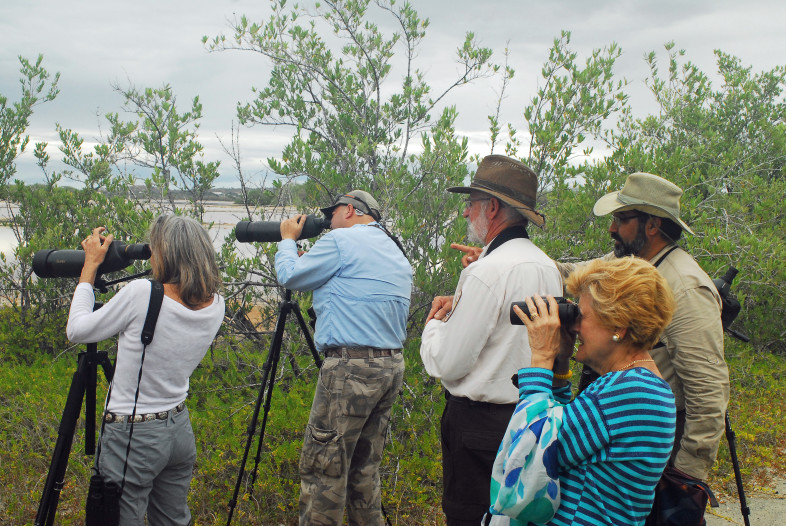
Scanning the Cabo Rojo salt pans for shorebirds, January 2016. Photo courtesy of Jack Stites.
Fill a bus with 20 bird enthusiasts and two seasoned local birders, turn them loose for 2 ½ days to scour western Puerto Rico, and two results are guaranteed: a healthy bird list and a memorable experience for all. Both were accomplished during a recent birding trip organized by the Sociedad Ornitológica Puertorriqueña (SOPI), VCE’s primary partner on our two-year islandwide survey of Bicknell’s Thrush. With impressive logistical legwork by Ellen Seidman and Katie Schmidt, we followed a fail-safe itinerary that had us covering an array of bird-rich habitats across a north-south “transect”. I had the supremely good fortune to be invited as a visiting ornithologist, an offer I could in no way resist.
We convened early on the morning of January 29, first visiting Cambalache State Forest, where SOPI has an educational center and a network of trails through the site’s mesic limestone forests. We heard from Israel Guzman, SOPI’s President, who outlined the organization’s diverse programs, from educating citizens, to promoting Puerto Rico’s IBAs, to conducting avian inventories, all in the name of conservation. A leisurely introductory walk on one of Cambalache’s many trail loops netted the trip’s only Key West Quail-Dove, glimpsed by a few at the head of the pack, as well as good looks and listens to common endemics like Puerto Rican Tody, Vireo and Bullfinch.
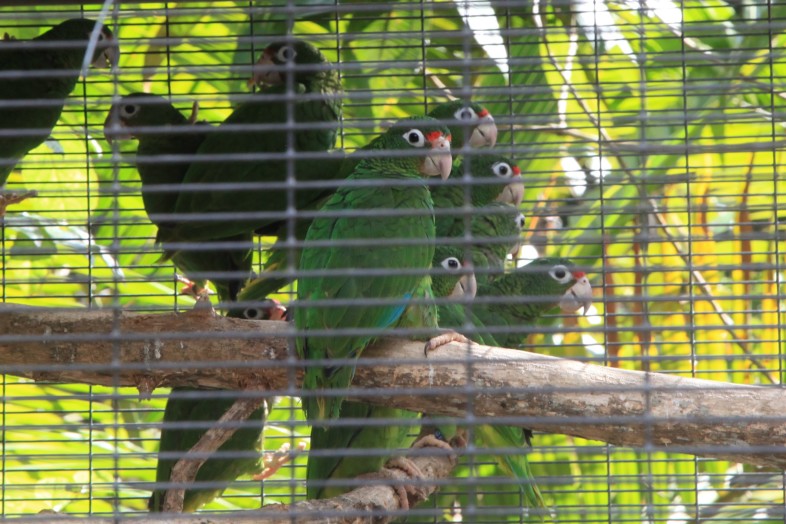
Captive-raised yearling Puerto Rican Parrots at the Rio Abajo facility, January 2016. Photo courtesy of Jon Borschow.
Next stop was Rio Aabajo, which provided one of our trip’s most memorable experiences. VCE’s good friend and SOPI co-leader Jose Salguero obtained permission for us to access the U.S. Fish & Wildlife Service Puerto Rican Parrot breeding facility, which is remote and off-limits to the public. Not only did we have several overhead glimpses of raucous, free-flying birds that had been recently released after captive-rearing, but we were treated to close encounters with several captive yearlings and a detailed history of the successful recovery operation by the facility’s impressive professional staff.
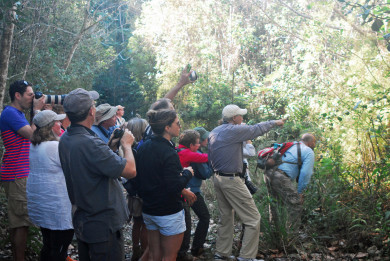
“Look, there it is! Foraging in that thicket!” The elusive Elfin-woods Warbler finally shows itself at Maricao State Forest. Photo courtesy of Jon Borschow.
After a fine meal and good night’s sleep at the Copamarina Beach Resort, our bus was rumbling by 7 am the next morning, as we headed north and upward in elevation to the Maricao State Forest. Here our primary quest was the endemic and globally rare Elfin-woods Warbler, for which Marico is the species’ stronghold. A cool and breezy morning challenged us to hear its high-pitched songs and calls in the dense elfin forest. Hopes were beginning to dim when Jose’s sharp ears picked one out. Persistence paid off, and nearly everyone had fine, if fleeting, looks at this diminutive warbler, for many birders the holy grail of Puerto Rican endemics. Maricao also furnished the trip’s only encounters with Puerto Rican Tanagers and Spindalis.
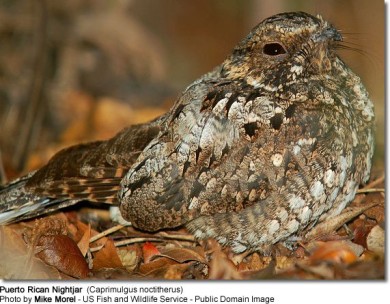 Snaking our way back down the tortuously winding route we had ascended hours earlier, it was back to the lowlands for lunch at Cabo Rojo National Wildlife Refuge Headquarters, where we were introduced to the refuge’s history and programs by soon-to-retire manager Oscar Diaz, who led us on a short (and very hot) post-lunch walk. The remainder of our afternoon was divided between Cabo Rojo’s salt pans (highlights included Royal and Sandwich Terns, and 10 shorebird species, with a surprise find of 3 winter-plumaged Ruddy Turnstones) and the legendary Cartagena Lagoon, which produced a panoply of ducks (including 65 White-cheeked Pintails, but no hoped-for West Indian Whistling Ducks), several Glossy Ibis, and 8 comical Smooth-billed Anis.
Snaking our way back down the tortuously winding route we had ascended hours earlier, it was back to the lowlands for lunch at Cabo Rojo National Wildlife Refuge Headquarters, where we were introduced to the refuge’s history and programs by soon-to-retire manager Oscar Diaz, who led us on a short (and very hot) post-lunch walk. The remainder of our afternoon was divided between Cabo Rojo’s salt pans (highlights included Royal and Sandwich Terns, and 10 shorebird species, with a surprise find of 3 winter-plumaged Ruddy Turnstones) and the legendary Cartagena Lagoon, which produced a panoply of ducks (including 65 White-cheeked Pintails, but no hoped-for West Indian Whistling Ducks), several Glossy Ibis, and 8 comical Smooth-billed Anis.
Our final morning together featured a pre-dawn foray by several early-risers in quest of Puerto Rican Nightjars. This seldom-seen “goatsucker” joins Elfin-woods Warbler as an exceedingly rare endemic; its cryptic plumage and nocturnal habits ensure that few birders ever meet one face-to-face. However, nightjars are impressively vocal year-round, and we hoped to hear an emphatic “whip, whip, whip” or two as we walked along the road. However, we certainly didn’t expect to be treated to a chorus of 8 birds ringing from the dry forested hillsides! As dawn broke, the nightjar symphony subsided, and a chorus of Caribbean Elaenias, Adelaide’s Warblers, and Venezuelan Troupials (an exotic species no one resents!) took over. Back to Copamarina for breakfast, and it was off to our final birding spot, Guanica State Forest, where 8 am temperatures were already fast climbing. A leisurely hike here yielded a banded Pearly-eyed Thrasher in the parking lot (the Guanica Avian Monitoring Project has been underway annually since 1972), a calling Mangrove Cuckoo, and two migrants found nowhere else on our trip: Prairie Warbler and Hooded Warbler.
Our final tally: 80 species overall and 13 of the island’s 17 endemics. No one was the least bit disappointed as we loaded the bus for our return trip to Dorado. Our 2+ days together had formed and cemented friendships, ignited birding passions, and fostered a genuine appreciation for SOPI’s fine work. Jon Borschow nicely captured our trip’s highlights’s in this photographic essay: https://jonborschow.smugmug.com/Puerto-Rico-Birding-Weekend/.
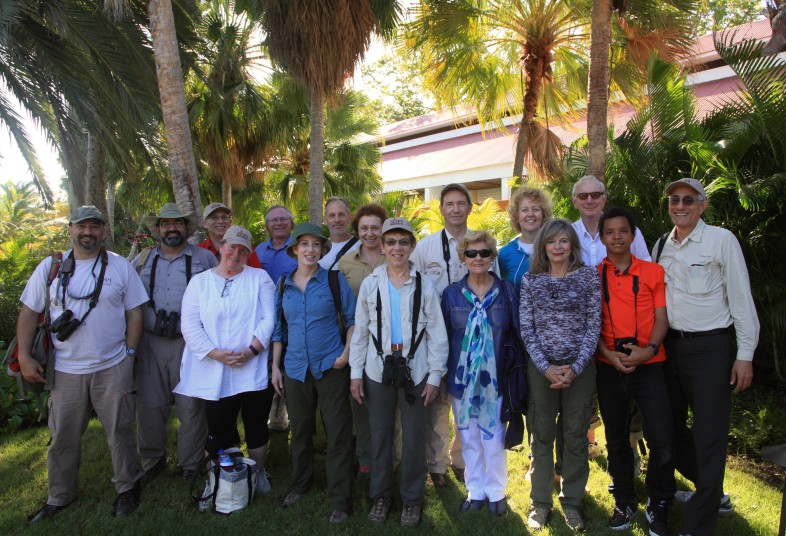
The SOPI birding tour group. From left to right: Jose Salguero, Israel Guzman, Greg Kaufman, Katie Schmidt, Will Schmidt, Ellen Seidman, Chris Rimmer, Galina Borschow, Penny Shackelford, Greg Shackelford, Maggie Van Kirk, Peggy Van Kirk, Annie Schmidt, Jack Stites, Edgar Van Kirk, Jon Borschow (photographer).
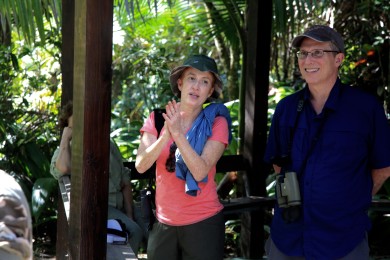
Ellen Seidman and Greg Kaufman, Rio Abajo, January 2016.
Finally, we all owe a huge debt of thanks to our impeccably-organized trip coordinator, patient task mistress, and good-natured “Mother Hen” Ellen Seidman (and by extension husband Greg). Without Ellen (AND the yeawoman’s help Katie Schmidt provided), this trip could never have taken place, let alone been such a successful, fun experience for every one of us.
